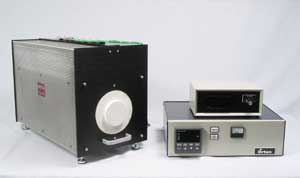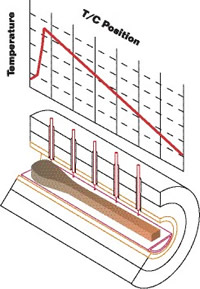 Place
an extruded column of a green ceramic, a row of pressed discs or parts,
a trough of granular raw material, or a glazed substrate on the D-tube
hearth and into the Orton MD Series Gradient Furnace. Set the controller
for a specific thermal cycle, them walk away to perform other tasks.
After the furnace cools, remove the samples and record their position on
the D-tube hearth. Since one end of the row of materials was cooler then
the other, you can immediately see how the range of firing temperatures
affected the shrinkage, color, porosity, particle size, degree of
vitrification, and other ceramic properties that are temperature
dependent. Place
an extruded column of a green ceramic, a row of pressed discs or parts,
a trough of granular raw material, or a glazed substrate on the D-tube
hearth and into the Orton MD Series Gradient Furnace. Set the controller
for a specific thermal cycle, them walk away to perform other tasks.
After the furnace cools, remove the samples and record their position on
the D-tube hearth. Since one end of the row of materials was cooler then
the other, you can immediately see how the range of firing temperatures
affected the shrinkage, color, porosity, particle size, degree of
vitrification, and other ceramic properties that are temperature
dependent.
The Orton Model GTF-MD-15
(1,500°C maximum) and GTF-MD-16 (1,600°C maximum) Series Furnaces are
a specially designed horizontal tube furnaces with controlled,
reproducible, linear thermal gradients of approximately 120°C across a
12" long monitored zone. The Orton Model GTF-MD-15L and GTF-16L
Series Furnaces are longer versions with controlled, reproducible,
linear thermal gradients of approximately 320°C across a 16" long
monitored zone. Thermocouples on 2" centers monitor the
temperatures along the gradient zone, so the temperature of the material
at any position along the D-tube hearth is known. Visual or post firing
analyses of sections taken from the fired material at any position along
the D-tube hearth can be measured, recorded, and studied as a function
of temperature.
 |
The Orton GTF-MD Series
Furnace is a specially designed horizontal tube furnace with a
controlled, reproducible, approximately linear thermal gradient across a
12" or 16" long monitored zone. |
 |
The furnace is a
rectangular, metal shell structure that houses the
refractory fiber insulation and four molybdenum disilicide heating
elements that surround one end of the 3” ID ceramic heating
chamber tube. The samples to be fired are placed on the top of the
2.5” wide high alumina D-tube hearth, which rests on the bottom of
the ceramic heating chamber tube. Type “S” thermocouples are
spaced on 2” centers along the monitored zone and extend
vertically through the top of the heating chamber tube. Two
specially shaped IFB end plugs are included to cover both ends of
the furnace.
|
 |
The furnace temperature is
controlled by the Universal Temperature Control Console (UTC). The
UTC contains the user programmable, multi-segment PID controller,
the phase-angle-fired SCR solid state power module, ammeter, ON/OFF
power switch and appropriate electrical receptacles. The PID
controller uses the thermocouple at the hot end of the furnace for
control, so the monitored gradient falls from this control
temperature.
|
 |
Electrical power from the
UTC runs through the included step-down transformer and on to the
molybdenum disilicide heating elements.
|
 |
The Temperature Display
Cabinet contains a digital panel display, rotary selector switch and
appropriate electrical receptacles to display the temperatures of
the other thermocouples along the length of the monitored zone. The
system includes all interconnecting cables and instruction manual.
The Temperature Display Cabinet requires 120 VAC, 15-amp power. The
UTC requires 240 VAC, 20-amp, 50/60 hertz input power. |
|
|
 |

|
 Place
an extruded column of a green ceramic, a row of pressed discs or parts,
a trough of granular raw material, or a glazed substrate on the D-tube
hearth and into the Orton MD Series Gradient Furnace. Set the controller
for a specific thermal cycle, them walk away to perform other tasks.
After the furnace cools, remove the samples and record their position on
the D-tube hearth. Since one end of the row of materials was cooler then
the other, you can immediately see how the range of firing temperatures
affected the shrinkage, color, porosity, particle size, degree of
vitrification, and other ceramic properties that are temperature
dependent.
Place
an extruded column of a green ceramic, a row of pressed discs or parts,
a trough of granular raw material, or a glazed substrate on the D-tube
hearth and into the Orton MD Series Gradient Furnace. Set the controller
for a specific thermal cycle, them walk away to perform other tasks.
After the furnace cools, remove the samples and record their position on
the D-tube hearth. Since one end of the row of materials was cooler then
the other, you can immediately see how the range of firing temperatures
affected the shrinkage, color, porosity, particle size, degree of
vitrification, and other ceramic properties that are temperature
dependent.